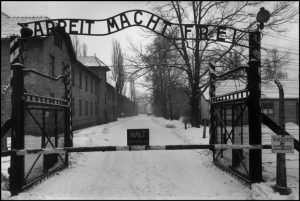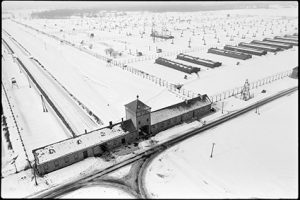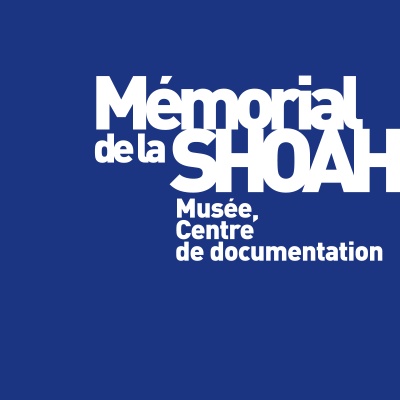Auschwitz-Birkenau
seen by Raymond Depardon
exhibition
Thursday, June 26, 2025During Sunday, November 09, 2025
In 1979, for two weeks, photographer and film director Raymond Depardon took a series of black-and-white photographs on the site of Auschwitz-Birkenau. These images, a commission from the magazine Paris Match, were published just after their production in several international magazines.
It is an Auschwitz-Birkenau under the snow that Raymond Depardon discovers. The immaculate whiteness of the landscape contrasts with the darkness of the buildings and fences of the camp and the vegetation that emerges there and there. An impression of solitude and geometric immensity emerges, punctuated by elements reminiscent of humans: a prisoner’s dress, a grass, a tree. Not a soul that lives. Covered in powdered white, the camp, and what we know about it, is indeed there, and Raymond Depardon grasps its most significant elements.
Twenty years later, he will return with Claudine Nougaret and their two sons for a personal visit to these places, an approach they consider essential.
On the occasion of the 80° commemoration of the end of the Second World War and the Shoah, Raymond Depardon agreed to publish the photographic series that reports on the site which has become a museum since 1947. These photographs had never been the subject of an exhibition or a dedicated publication.
On the occasion of the exhibition, "Auschwitz Birkenau as seen by Raymond Depardon," the photographer-director chose to entrust all the photographs to the Shoah Memorial.
The photographs will be preserved at the Shoah Memorial and available for consultation on the online catalogue of the photo library.
Requests for use should be addressed to the Magnum agency.
Coordination: Sophie Nagiscarde, Clara Lainé, assisted by Andréa Pechin, Shoah Memorial.
Scenography: Studio Adrien Gardère – Adrien Gardère, Carole Pfendler, Juliane Servais
New! Discover the cycle around the exhibition
INTERVIEW WITH RAYMOND DEPARDON
Excerpt from the interview with Raymond Depardon, published on the occasion of the exhibition, in the beautiful book Auschwitz-Birkenau vu par Raymond Depardon.
The magazine Paris Match sends you to the winter of 1979 on the site of the former camp of Auschwitz-Birkenau to make a photographic report. How do you approach this type of place when you are a documentary maker, filmmaker, and photographer? Did you document yourself before leaving, had you seen images made by other photographers?
Raymond Depardon:
No, I didn’t really document myself. In 1979, I had just moved from the Gamma agency to the Magnum agency, which was an event for me. I was coming back from several quite difficult reports and I was still a bit orphaned by Gilles Caron, who had disappeared ten years earlier in Cambodia, captured by the Khmer Rouge. With other photographers, we were all very marked by Vietnam.
As often happens in newspapers – it’s almost a caricature – I’m asked: "Raymond, could you go do a report at Auschwitz for Paris Match?" So I answer yes and find myself there one morning. It was one of the biggest shocks of my life. I asked myself: "But what is this? A film set? A horror movie?"
I then decided to visit everything. Every day, I discovered the horror. I was trying to visit little by little, because I had to work; without that, I would have been stunned, I would have sat down and done nothing. I start with the Auschwitz barracks. The site is in very good condition: an old Polish barracks. We recognize the gate, of course. It was winter, under the snow. I worked meticulously. I admit that I was trying to keep my composure. When you are a photographer, you have to keep your composure.
With which material did you work?
At the time, I wasn’t working in the room yet and I had a lot of very slow films that I used to photograph the desert. I thought they would be perfect and that I would work on foot.
How were you received by the memorial staff? Were you guided to visit the camp?
Yes, at the beginning, they showed me the places where people slept, the ovens, the place where trains arrived, the place where Jews disembarked.
They also showed me films. I was very impressed by the one of the Red Army cameramen who discover the camp. It’s a crazy movie, incredible. For me, it’s one of the most moving films in the world because I believe they were really surprised. I believe they knew, but they didn’t expect what they saw.
They filmed with a KS-4 camera, Soviet copy of the Eyemo Bell & Howell, which is a wonderful camera. When I did Ian Palach in 1969, I filmed a minute of silence with this Bell & Howell camera. It is a portable camera that does not protect you so much from what you film. Afterwards, while filming Faits divers or shooting in the courthouses, I was protected by the camera. Fortunately, otherwise I would have snapped. For Claudine, who was recording, it was more difficult: she was exposed. People were staring at her and calling out to find help.
In this Soviet film, they do something that I would never have dared to do: fixed shots of the few surviving people. One imagines this winter 1945. They are released, but they have not left the camp. They must be relieved to see the Soviets arrive, but they are in such a state... The cameramen take close-ups of people hanging on the barbed wire, still shots, like photos. One sees, for example, the eyebrows or the mouth of these survivors who barely move.
I have the impression that before this end of the 1970s, little had been said about Auschwitz and the Holocaust.
Speech by Raymond Depardon at the inauguration
The Auschwitz-Birkenau complex
Established by the Nazi authorities on the outskirts of the small town of Owiêcim, the Auschwitz complex spread from spring 1940 into a region particularly rich in raw materials: Silesia, newly conquered and attached to the Reich. Between the Vistula and the Soła, the SS create the area of interest of KL Auschwitz with an area of more than 40 km 2. This area, under permanent surveillance, had to be as sparsely populated as possible in order to prevent the Poles from becoming potential witnesses of what was happening in the region and to avoid contacts between civilians and deportees as much as possible. Initially conceived as one of the concentration camps of the Reich, Auschwitz quickly established itself as a gigantic concentration camp complex endowed with numerous sub-camps, near which several German companies settled. Starting in the spring of 1942, Auschwitz also established itself as the most murderous of the Jewish killing centres in Europe.
Within this vast ensemble, three spaces are particularly distinguished:
- Auschwitz I, the main camp (or stump camp), founded by the SS in early 1940 within a former barracks of the Polish army.
- Auschwitz II (Birkenau), whose construction began in 1941 on the site of the village of Brzezinka, a few kilometers from the main camp. From 1942, and until the summer of 1944 when the number of deportees reached nearly 100,000, Birkenau was a huge concentration camp, but also the place where the process of mass extermination of the Jews of Europe took place.
- Auschwitz III (Monowitz or Buna-Monowitz), where a huge industrial complex for the production of synthetic rubber in favor of the German company I.G. Farben was established, from autumn 1942, near the village of Monowitz. The camp, which was set up near the factory, became so important that in November 1943 it became a fully-fledged camp with its own sub-camps.
Gradually emptied of its remaining valid deportees between the autumn and the month of January 1945, and discovered by the Soviets on January 27 of the same year, the Auschwitz complex disappears but the places remain and evolve. The Polish authorities take over the site of the former concentration camp complex. They give up the remaining barracks of Birkenau to the local populations and, under pressure from Polish survivors of the camp, decide to make Auschwitz I a museum. The law of 2 July 1947 on the establishment of the Martyr’s Museum in Oświęcim, passed by the Polish Parliament, officially ratified the decision to preserve ad aeternam the site of the former Auschwitz-Birkenau camp and to create a museum there (which today bears the name of the Auschwitz-Birkenau State Museum). The weight of memory of Auschwitz in the collective imagination, particularly on a French scale because it was the place where the overwhelming majority of Jews deported from France were murdered, is very important.

Entrance gate of the Auschwitz camp 1. © Raymond Depardon / Magnum Photos

The interior of a camp shack (sector BI), now a women’s camp. © Raymond Depardon / Magnum Photos

Aerial view of the Birkenau site. © Raymond Depardon / Magnum Photos

Barbed wire fences at the Birkenau camp. © Raymond Depardon / Magnum Photos
Beautiful book Auschwitz-Birkenau seen by Raymond Depardon on the occasion of the exhibition

Beau-livre
Auschwitz-Birkenau as seen by Raymond Depardon
Coédition: Mémorial de la Shoah, Calmann-Lévy, 128 pages.
Price: 22 €
In bookstores on June 25, 2025.
On sale at the Shoah Memorial.





